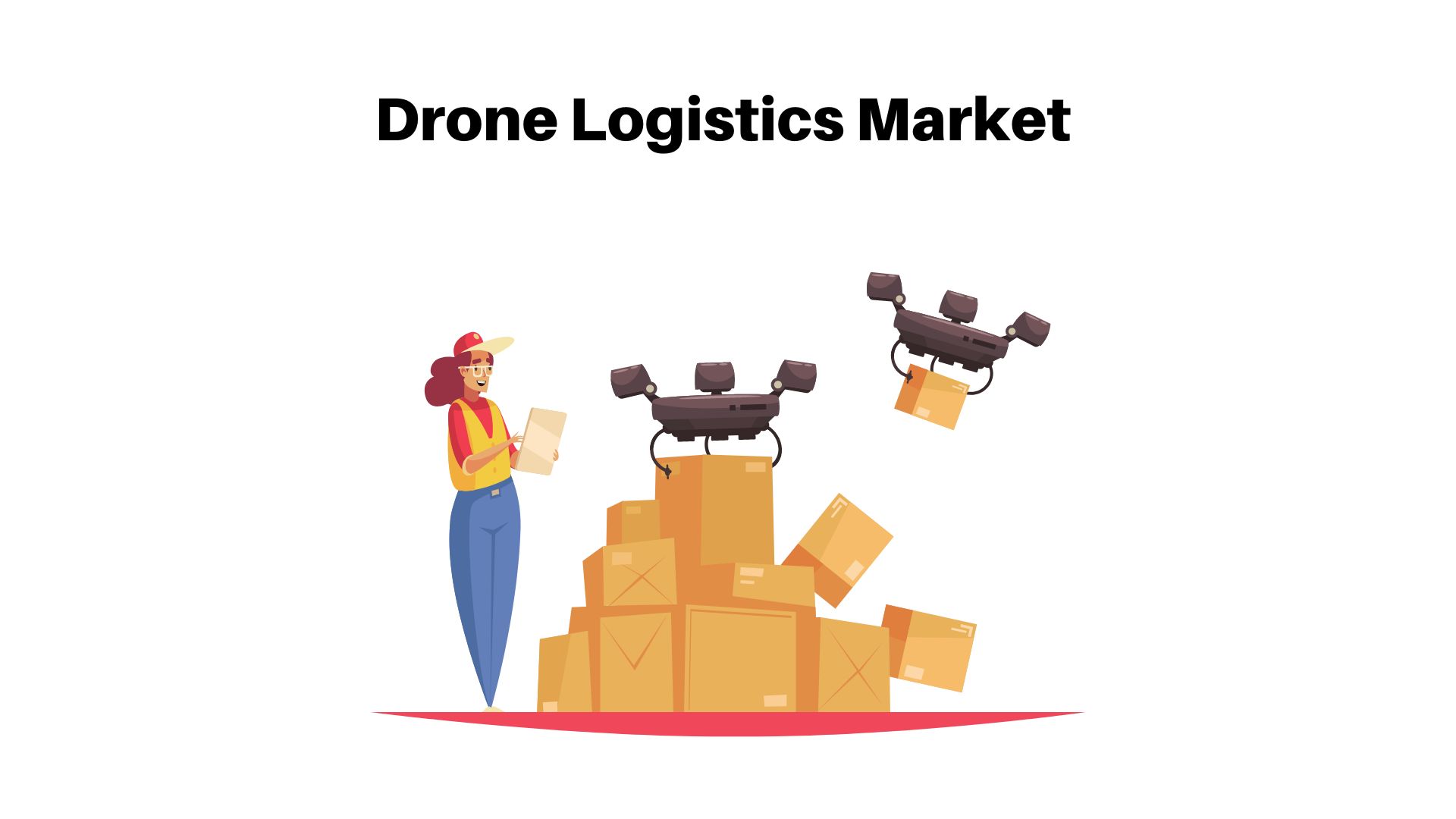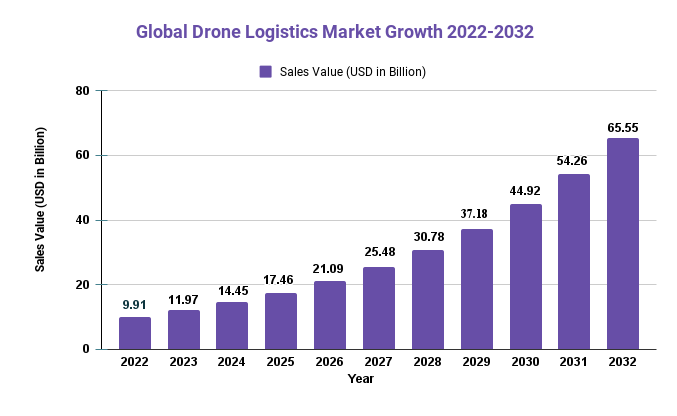Drone Logistics Market (CAGR 20.8% )Technical Report + Feasibility Study, 2022-2032

Page Contents
Market Overview
The drone logistics market has seen rapid expansion over the last several years due to an increasing need for faster and more efficient delivery systems. According to various industry reports, the drone logistics market is expected to maintain its growth trajectory over the coming years with a compound annual growth rate (CAGR) of more than 20.8% between 2022 and 2032. With the rise of e-commerce and demand for same-day or next-day delivery becoming increasingly commonplace, demand for drone logistics services has also grown substantially. Drones offer a cost-effective and speedy solution for delivering packages and goods over short distances, especially in hard-to-reach places or during natural disasters. In 2022, the drone logistics market was valued at USD 9.91 billion; projected to reach USD 65.55 billion by 2032 with an annual compound growth rate (CAGR) of 20.8% from 2022-2032.
In terms of application, the drone logistics market can be divided into three major categories: transportation drones, freight drones and delivery drones. Transportation drones are employed for transporting goods between warehouses while freight drones cover long distances. Delivery drones serve as last-mile delivery solutions and may deliver packages directly to customers' homes or businesses.
North America and Europe are the two primary markets for drone logistics, due to the presence of e-commerce companies and an encouraging regulatory climate. However, Asia-Pacific is predicted to experience rapid growth in this space due to rising demand for faster delivery systems in countries like China and India. Overall, analysts forecast that global drone logistics revenue will increase significantly over the coming years, due to this increasing need for efficient systems.
Drone logistics is the practice of using drones or unmanned aerial vehicles (UAVs) for transporting goods or packages between locations. This market is expected to expand rapidly over the coming years due to an increasing need for faster and more efficient deliveries of items.

Request For Sample Report: https://market.us/report/drone-logistics-market/request-sample/
Key Takeaways
- The global drone logistics market is projected to experience an annual compound growth rate (CAGR) of 20.8% between 2022-2032, due largely to rising demands for faster delivery times and more efficient operations.
- The commercial segment is expected to dominate the drone market share due to its expanding use in industries such as e-commerce, healthcare, and food delivery.
- The delivery drones segment is expected to dominate the market due to their growing use in sending small packages and medical supplies.
Regional Snapshot
North America is expected to dominate the drone logistics market due to a number of major players and increasing investments in drone technology. The United States is predicted to lead this region's market.
Europe: This region is expected to experience rapid growth due to the increasing adoption of drone technology for e-commerce and healthcare applications.
Asia-Pacific: This region is expected to experience the highest growth rate during the forecast period due to increasing drone adoption in countries like China and Japan.
Middle East & Africa: This region is expected to experience rapid growth due to the rising use of drones for military and surveillance purposes.
Latin America: This region is expected to experience significant growth due to the increasing adoption of drone technology in the agriculture and mining industries.
Drivers
- Growing demand for faster and more efficient delivery of goods
- Rising adoption of drone technology in e-commerce, healthcare, and food delivery industries
- Advancements in drone technology such as longer flight times, improved battery life, and advanced sensors will continue to fuel this growth.
- Investments in drone technology by governments and private companies
- Growing demand for medical supplies and emergency services in remote areas
Restraints
- Drone operations face regulatory obstacles, such as air traffic management and safety concerns; limited payload capacity of delivery drones; high costs associated with drone technology such as maintenance and repair costs
- Drone operations may be limited due to limited range and weather conditions that could impact performance. There also exist privacy and security risks that come along with drone operations.
Opportunities
Faster Delivery: Drone logistics can offer faster delivery times, which could be advantageous for time-sensitive items like medical supplies, emergency response equipment, and perishable goods.
Cost-Effective: Drone logistics may reduce transportation expenses and boost efficiency, particularly for short-distance deliveries.
Remote Locations: Drones can reach remote areas where traditional transportation methods are difficult or impossible, such as mountainous regions or islands.
Environmental Benefits: Drone logistics could potentially reduce carbon emissions from transportation, making it a more sustainable and eco-friendly choice.
Challenges
Regulations: Drone logistics must contend with a variety of regulatory obstacles, such as restrictions on airspace and restrictions on the weight and size of packages that can be delivered.
Technology Limitations: Current drone technology may not be capable of handling large, heavy or delicate packages, which could restrict its applications in certain industries.
Safety Issues: Drones can pose a safety threat to both people and property if they malfunction or are not operated correctly.
Weather Conditions: Inclement weather conditions, such as high winds or heavy rain, can affect drone operations and make it difficult or impossible to deliver packages.
Grow your profit margin with Market.us Get this Report
Recent Developments
Amazon Prime Air: Amazon has begun testing drone delivery as part of their Prime Air service, which aims to deliver packages within 30 minutes.
Wing Aviation: Alphabet's Wing Aviation has been testing drone delivery services in Virginia and Australia, working with businesses like Walgreens and FedEx.
UPS Flight Forward: UPS has unveiled UPS Flight Forward, which offers drone delivery services for healthcare supplies and other essential items.
FAA Regulation Changes: Recently, the Federal Aviation Administration (FAA) made changes to its regulations that permit more commercial drone usage – potentially opening the door for drone logistics services.
Key Market Segments
Type
- Freight Drones
- Passenger Drones
- Ambulance Drones
Application
- Military
- Commercial
Key Market Players included in the report
- PINC Solutions
- CANA Advisors
- Drone Delivery Canada
- Dronescan
- Hardis Group
- Infinium Robotics
- Matternet
- Workhorse Group
- Skycart
- Skysense
- Zipline
- Flirtey
- Flytrex
- Altitude Angel
- Airmap
- Skyward Io
Report Scope
| Report Attribute | Details |
| The market size value in 2022 | USD 9.91 Bn |
| Revenue forecast by 2032 | USD 65.55 Bn |
| Growth Rate | CAGR Of 20.8% |
| Regions Covered | North America, Europe, Asia Pacific, Latin America, and Middle East & Africa, and Rest of the World |
| Historical Years | 2017-2022 |
| Base Year | 2022 |
| Estimated Year | 2023 |
| Short-Term Projection Year | 2028 |
| Long-Term Projected Year | 2032 |
Frequently Asked Questions
Q: What kinds of packages can be delivered by drones?
A: Drones typically carry small and lightweight items like medications, parcels, and food items.
Q: How far can drones travel?
A: The distance a drone is capable of traveling depends on several factors, such as its type, battery life and weather conditions. On average, drones can cover between 20-30 minutes on one charge with minimal battery drain while covering several miles in distance.
Q: Are drones safe?
A: Drones can pose a safety hazard if not operated correctly or malfunction. Nevertheless, strict regulations exist to guarantee drones are operated responsibly and safely.
Q: Is There Regulation for Drone Logistics?
A: Absolutely, there are regulations in place for drone logistics, including weight and size limits on packages that can be delivered, as well as airspace restrictions that govern their operations.
Q: Which industries could benefit from drone logistics?
A: Industries such as healthcare, e-commerce, and food delivery could all gain from using drones for delivery purposes.
The team behind market.us, marketresearch.biz, market.biz and more. Our purpose is to keep our customers ahead of the game with regard to the markets. They may fluctuate up or down, but we will help you to stay ahead of the curve in these market fluctuations. Our consistent growth and ability to deliver in-depth analyses and market insight has engaged genuine market players. They have faith in us to offer the data and information they require to make balanced and decisive marketing decisions.



